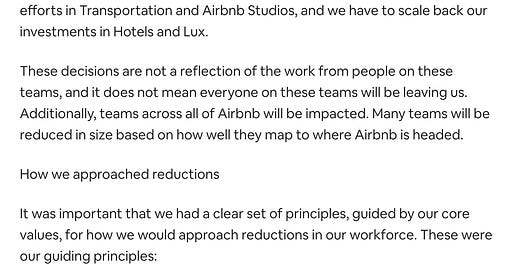How Brian Chesky led Airbnb through Times of Uncertainty using Design
Today, I had the chance to listen to Brian Chesky, Co-founder and CEO of Airbnb, talking about how design as a way of thinking has helped him lead Airbnb not just through the pandemic but also in its day-to-day operations.
Eight weeks before the company was just about to go public in early 2020, Airbnb lost 80% of its business due to the spread of COVID-19 in China. Brian recalled that their business flashed before his eyes. The media was publishing articles questioning whether this would be the end of Airbnb. This event forced Brian and his team to rebuild the company from the ground up which led Airbnb to not only avoid going out of business but also make $4 billion in free cash flow in 2022.
They went from a business unit organization (or divisional, employees grouped by divisions or branches) to a functional organization (employees grouped by specializations). With a designer background, for 10 years since Airbnb started in 2008, Brian has always wanted to run the company as a designer, a more creative process rather than the scientific method that many companies often run. But he never had the nerves to run it in the way that he really wanted until he was forced to rebuild the company from the ground up after being hit by the pandemic.
How did Brian rebuild Airbnb in times of uncertainty?
After adopting a functional organizational structure, Brian created one single roadmap for the entire company and he asked all the team leads to put everything they wanted to ship into one single roadmap. There was one rule: only ship things that you are proud of; if you don’t want to put your name on the task/product, you don’t ship it.
Then, he told the team that we could only do 10% of the thing on the roadmap and asked them to point out the 10% they should focus on. Instead of pushing decision-making from the top down, Brian pulled decision-making in from the top 30 to 40 people of the company and created a shared neural network when working together.
In addition, Brian shared that the team didn’t have permission to build new things when there are still customer complaints about their core services and products.

How far into the future does Brian plan?
Through his story of leading Airbnb through its hardest time in the company’s history, we might wonder whether Brian thinks very far ahead in the future. He shared that as a CEO he is in charge of the company’s roadmap. He typically has a roadmap for the next 3 years; however, 2 and 3 years out can get a bit fuzzy. But he always has a pretty good idea of what Airbnb ships in the next 1 year and a half (so for example, what Airbnb will ship in November 2023, April 2024, and November 2024). He reviews the roadmap every week, every 2 weeks, every month, etc. The long-term roadmap is constantly changing and updating as he observes how the short-term roadmap plays out while the short-term roadmap hopefully doesn’t change that much.
What are some of the design principles Brian cultivates in his team?
Being customer-centered (talking to them is not enough!): Talking to customers is not enough. You have to get a bird’s eye view of the entire experience. You need to be systematic about how to talk to customers: talking to them, looking at data, understanding the data, using the product yourself, or becoming your own user/customer. You need to have a deep understanding of the problem and observe as much information as possible. This deep understanding will over time become your intuition.
Being hypothesis-driven: When doing experimentation testing a new feature or a new product, it should be hypothesis-driven. If the experimentation works, you are able to say why not just what. Why did it work? What things led to it? Once we ship, we will look at how people use it and at the data, but there always has to be a hypothesis upon which we can reason why or why not the experimentation doesn’t work.
Loving what you build: You should only ship if you are proud of what you design. Don’t ship something until you are happy. The artist in you first and foremost must make something that you yourself want it.
Simplifying as a way to truly understand the problems you are working on: Simplifying isn’t removing things. Simplifying is distilling something to its essence. In order to distill something, you have to deeply understand it, which goes back to point number 1.
Starting product development with marketing side by side: Something very important for my own startup that I learned from Brian’s talk is the importance of product and marketing collaboration from the early stages of the product development cycle. We need to start product development with marketing. In Airbnb’s case, Brian sometimes has the marketing team lead the vision of the product. What marketing campaigns are we going to do? What kinds of stories are we telling about the product? We can’t develop a product unless we can talk about the product.
For Brian, design isn’t a single function or a department. Design is how things fundamentally work and is a way of thinking about the world.
At the end of the day, we are making a product that people want and love and that we also love. In order for a company to succeed, we need to have more heart and more imagination and every single person or function of the company has the ability to do so.



